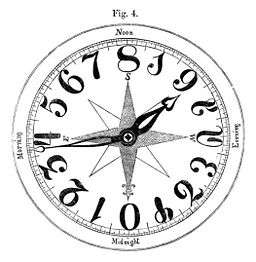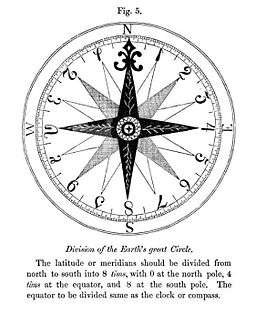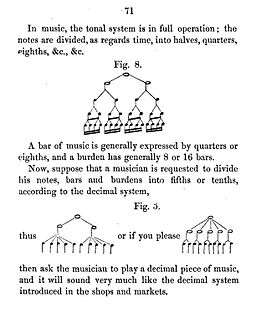Tonal system
The tonal system is a base 16 system of notation (predating the widespread use of hexadecimal in computing), arithmetic, and metrology proposed in 1859 by John W. Nystrom.[1] In addition to new weights and measures, his proposal included a new calendar with sixteen months, a new system of coinage, and a clock with sixteen major divisions of the day (called tims). Nystrom advocated his system thus:
I am not afraid, or do not hesitate, to advocate a binary system of arithmetic and metrology. I know I have nature on my side; if I do not succeed to impress upon you its utility and great importance to mankind, it will reflect that much less credit upon our generation, upon scientific men and philosophers.[2]

Names for the numbers
He proposed names for the digits, calling zero "noll" and counting (from one to sixteen):
"An, de, ti, go, su, by, ra, me, ni, ko, hu, vy, la, po, fy, ton." (Therefore, tonal system.)
Because hexadecimal requires sixteen digits, Nystrom supplemented the existing decimal digits 0 through 9 with his own invented characters (shown on his clockface above) and changed the value of 9 to ten. Later, the hexadecimal notation overcame this same obstacle by using the digits 0 through 9 followed by the letters A through F.
The numbers 1116 and 1216 would be said "tonan", "tonde", etc. The table below shows Nystrom's names for successive powers of 1016.
| Base 16 Number | Tonal Name | Base 10 Equivalent |
|---|---|---|
| 10 | ton | 16 |
| 100 | san | 256 |
| 1000 | mill | 4,096 |
| 1,0000 | bong | 65,536 |
| 10,0000 | tonbong | 1,048,576 |
| 100,0000 | sanbong | 16,777,216 |
| 1000,0000 | millbong | 268,435,456 |
| 1,0000,0000 | tam | 4,294,967,296 |
| 1,0000,0000,0000 | song | 16^12 |
| 1,0000,0000,0000,0000 | tran | 16^16 |
| 1,0000,0000,0000,0000,0000 | bongtran | 16^20 |
Thus, the hexadecimal number 1510,0000 would be "mill-susanton-bong". This first hexadecimal system, proposed in the 19th century, has thus far not achieved widespread usage.
Although Nystrom did not propose a language for tonal fractions, his nomenclature for units of measure does provide one: the name of a power of sixteen before the base unit's name multiplies it by that number, but a power of sixteen after the base unit's name divides it by that number. Thus, de timtons means 1⁄8 tim.
Geography

For latitudes he put 0 at the North Pole, 4 at the equator and 8 at the South Pole. The units were called tims. They are the same as the colatitudes measured in turns times 16.
| Tonal (in tims) | ISO 6709 | Colatitude (in degrees) | Colatitude (in turns) |
|---|---|---|---|
| 0 | 090 | 0° | 0 |
| 1 | 67.5 | ||
| 2 | 045 | 45° | 0.125 |
| 3 | 022.5 | ||
| 4 | 000 | 90° | 0.25 |
| 5 | −22.5 | ||
| 6 | −045 | 135° | 0.375 |
| 7 | −67.5 | ||
| 8 | −090 | 180° | 0.5 |
Music

In his book he made a reference to music notation, where binary division is already in use for time. He also discussed the problem of pitch inflation, which he proposed to solve by setting the A below middle C to a frequency of san per timmill (194 Hz).
References
- Nystrom, John W. Project of a New System of Arithmetic, Weight, Measure and Coins, Proposed to be Called the Tonal System, with Sixteen to the Base
- (Quotation: John W. Nystrom, ca. 1863) The Art of Computer Programming section 4.1, Donald Knuth.